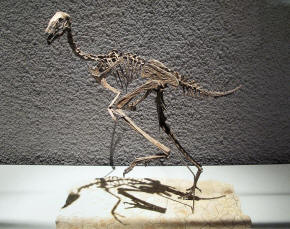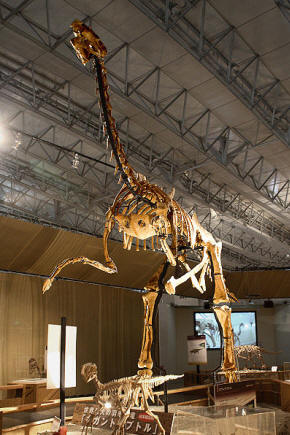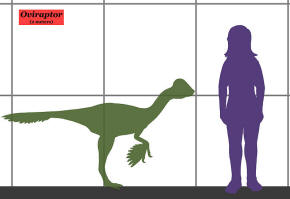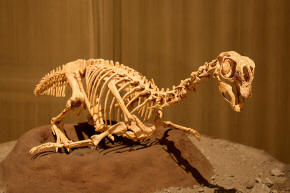They ranged in size from Caudipteryx, which was the size of a turkey, to the 8 meter long, 1.4 ton Gigantoraptor. The group (along with all maniraptoran dinosaurs) is close to the ancestry of birds. Analyses like those of Osmolska et al. (2004) suggest that they may in fact represent primitive flightless birds. The most complete oviraptorosaur specimens have been found in Asia. The North American oviraptorosaur record is "unfortunately" sparse.
Description
Oviraptorosaurians are different from most other maniraptorans in the form of their skulls. They have shortened snouts, beak-like jaws with few or no teeth, and a large opening in the lower jaw bone. Some have bony crests atop the skull. The most primitive members have a few teeth in the front of the mouth; in Incisivosaurus, they are enlarged and form bizarrely prominent "bucktoothed" incisors. The arms and hands are generally long (though very reduced in some advanced species) and the shoulder girdle is large and massive, with flexed coracoid bones and prominent attachments for strong arm muscles.
Their tails are very short compared to other maniraptorans. In Nomingia and Similicaudipteryx, the tail ends in four fused vertebrae which Osmólska, He, and others have referred to as a "pygostyle", but which Witmer found was anatomically different and evolved separately from the pygostyle of birds (a bone which serves as the attachment point for a fan of tail feathers).
Feathers
Evidence for feathered oviraptorosaurs exists in several forms. Most directly, four species of primitive oviraptorosaurs (in the genera Caudipteryx, Protarchaeopteryx, and Similicaudipteryx) have been found with impressions of well developed feathers, most notably on the wings and tail, suggesting that they functioned at least partially for display. Secondly, at least two oviraptorosaur specimens (Nomingia and Similicaudipteryx) preserved tails ending in something like a pygostyle, a bony structure at the end of the tail that, in modern birds, is used to support a fan of feathers. Similarly, quill knobs (anchor points for wing feathers on the ulna) have been reported in the oviraptorosaurian species Avimimus portentosus. Additionally, a number of oviraptorid specimens have famously been discovered in a nesting position similar to that of modern birds. The arms of these specimens are positioned in such a way that they could perfectly cover their eggs if they had small wings and a substantial covering of feathers.
Paleobiology
Diet
The eating habits of these animals are not fully known: they have been suggested to have been either carnivorous, herbivorous, mollusk-eating or egg-eating (the latter is no longer considered valid); these options are not necessarily incompatible.
Some ate small vertebrates. Evidence for this comes from a lizard skeleton preserved in the body cavity of Oviraptor and two baby Troodontid skulls found in a Citipati nest. Evidence in favor of a herbivorous diet includes the presence of gastroliths preserved with Caudipteryx. There are also arguments for the inclusion of mollusks in their diet.
Originally these animals were thought to be egg raiders, based on a Mongolian find showing Oviraptor on top of a nest. Recent studies have shown that in fact the animal was on top of its own nest.
Reproduction
Several oviraptorosaurian nests are known, with several oviraptorid specimens preserved in a brooding position over large clutches of up to a dozen or more eggs. The eggs are usually arranged in pairs, and forming a circular pattern within the nest. One oviraptorosaurian specimen from China has been found with two unlaid eggs within the pelvic canal. This suggests that, unlike modern crocodilians, oviraptorosaurs did not produce and lay many eggs at the same time. Rather, the eggs were produced within the reproductive organs in pairs, and laid two at a time, with the mother positioned in the center of the nest and rotating in a circle as each pair was laid. This behavior is supported by the fact that the eggs were shaped like highly elongated ovals, with the more pointed end pointing backward from the birth canal, and also oriented toward the center of the nest.
The presence of two shelled eggs within the birth canal shows that oviraptorosaurs were intermediate between the reproductive biology of crocodilians and modern birds. Like crocodilians, they had two oviducts. However, crocodilians produce multiple shelled eggs per oviduct at a time, whereas oviraptorosaurs, like birds, produced only one egg per oviduct at a time.
Relationship to birds
Oviraptorosaurs, like dromaeosaurs, are so bird-like that several scientists consider them to be true birds, more advanced than Archaeopteryx. Gregory S. Paul has written extensively on this possibility, and Teresa Maryańska and colleagues published a technical paper detailing this idea in 2002. Michael Benton, in his widely-respected text Vertebrate Paleontology, also included oviraptorosaurs as an order within the class Aves. However, a number of researchers have disagreed with this classification, retaining oviraptorosaurs as non-avialan maniraptorans slightly more primitive than the dromaeosaurs.
Select Oviraptorosaurs
|
Caudipteryx (which means "tail feather") is a genus of peacock-sized theropod dinosaurs that lived in the Aptian age of the early Cretaceous Period (about 124.6 million years ago). They were feathered and remarkably birdlike in their overall appearance. Two species have been described; C. zoui (the type species), in 1998, and C. dongi, in 2000. Caudipteryx fossils were first discovered in the Yixian Formation of the Sihetun area of Liaoning Province, northeastern China in 1997. |
 |
| Gigantoraptor is a
genus of giant
oviraptorosaurian dinosaur that
lived 70 million years ago during the late
Cretaceous Period. It was discovered in 2005 in the
Iren
Dabasu Formation,
Erlian basin, in
Inner Mongolia.
Xu et al. found that it shared a common ancestor with and
belonged to the same family as
Oviraptor,
but in comparison, Gigantoraptor was much larger,
approximately 35 times larger than its likely close relative,
Caudipteryx.
At 8 metres (26 ft) long and weighing about 2 tonnes (2.2 tons) it
is nearly 3 times as long and much heavier than the largest
oviraptorosaur hitherto known,
Citipati. In
2010, a second analysis of Gigantoraptor relationships found
it to be a
caenagnathid rather than an oviraptorid (Picture Source) |
 |
|
Oviraptor is a genus of small Mongolian theropod dinosaur. Its name is Latin for 'egg thief', referring to the fact that the first fossil specimen was discovered atop a pile of what were thought to be Protoceratops eggs. In the 1990s, the discovery of nesting oviraptorids like Citipati showed that the eggs in question probably belonged to Oviraptor itself, and that the specimen was actually brooding its eggs. Oviraptor lived in the late Cretaceous period, during the late Campanian stage about 75 million years ago; only one definitive specimen is known (with associated eggs), from the Djadokhta Formation of Mongolia, though a possible second specimen (also with eggs) comes from the northeast region of Inner Mongolia, China, in an area called Bayan Mandahu. |
 |
| Conchoraptor was a small
dinosaur, only 1–2 meters (4–6 feet) in length. Unlike many other
oviraptorids, Conchoraptor lacked a head crest. Like its
relatives, it lacked teeth. Instead of teeth, oviraptorids had
powerful beaks, possibly adapted to crushing mollusk shells. The
skull of Conchoraptor was heavily pneumatised, with most of
the bones hollow. Internal connections between both ears functioned
as resonance chambers and improved hearing. (Picture Source) |
 |
Return to the Old Earth Ministries Online Dinosaur Curriculum homepage.
![]()
Shopping
Bay State Replicas - Chirostenotes Claw, Chirostenotes Foot, Oviraptor skull, Oviraptor egg, Oviraptor nests, Oviraptor embryo sculpture
Black Hills Institute - Claw, Egg Nest Replica, Macroelongatoolithus Egg Pair, Egg Nest Replica,